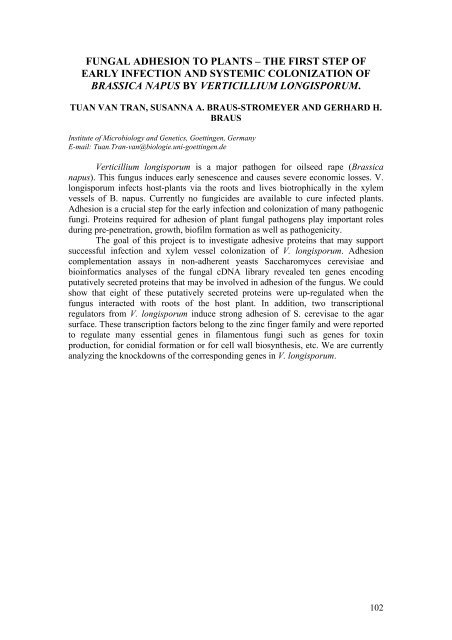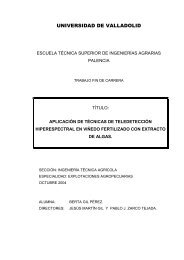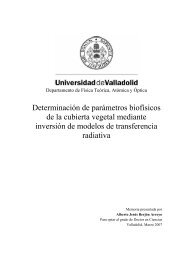FUNGAL ADHESION TO PLANTS – THE FIRST STEP OFEARLY INFECTION AND SYSTEMIC COLONIZATION OFBRASSICA NAPUS BY <strong>VERTICILLIUM</strong> LONGISPORUM.TUAN VAN TRAN, SUSANNA A. BRAUS-STROMEYER AND GERHARD H.BRAUSInstitute of Microbiology and Genetics, Goettingen, GermanyE-mail: Tuan.Tran-van@biologie.uni-goettingen.deVerticillium longisporum is a major pathogen for oilseed rape (Brassicanapus). This fungus induces early senescence and causes severe economic losses. V.longisporum infects host-plants via the roots and lives biotrophically in the xylemvessels of B. napus. Currently no fungicides are available to cure infected plants.Adhesion is a crucial step for the early infection and colonization of many pathogenicfungi. Proteins required for adhesion of plant fungal pathogens play important rolesduring pre-penetration, growth, biofilm formation as well as pathogenicity.The goal of this project is to investigate adhesive proteins that may supportsuccessful infection and xylem vessel colonization of V. longisporum. Adhesioncomplementation assays in non-adherent yeasts Saccharomyces cerevisiae andbioinformatics analyses of the fungal cDNA library revealed ten genes encodingputatively secreted proteins that may be involved in adhesion of the fungus. We couldshow that eight of these putatively secreted proteins were up-regulated when thefungus interacted with roots of the host plant. In addition, two transcriptionalregulators from V. longisporum induce strong adhesion of S. cerevisae to the agarsurface. These transcription factors belong to the zinc finger family and were reportedto regulate many essential genes in filamentous fungi such as genes for toxinproduction, for conidial formation or for cell wall biosynthesis, etc. We are currentlyanalyzing the knockdowns of the corresponding genes in V. longisporum.102
POTENTIAL OF LIGNIN INCORPORATION IN SOIL TOCONTROL <strong>VERTICILLIUM</strong> WILT OF CAULIFLOWERFRANÇA S.C. 1 , VAN BENEDEN, S. 1 , SPIESSENS, K. 2 , DE ROOSTER, L. 2 ,POLLET, S. 3 , CALLENS, D. 3 AND HÖFTE, M. 11 Laboratory of Phytopathology, Department of Crop Protection, Faculty of Bioscience Engineering,Ghent University, Coupure links 653, 9000 Ghent, Belgium;.2 Proefstation voor de Groenteteelt, Sint-Katelijne-Waver, Belgium.;3 Provinciaal Onderzoeks- en Voorlichtingscentrum voor Land- en Tuinbouw Rumbeke-Beitem,Belgium.E-mail: Soraya.deCarvalhoFranca@UGent.beVerticillium wilt is an important problem in Belgian cauliflower production.The disease is caused by Verticillium longisporum, a soil-borne pathogen which canpersist for many years in soil in the form of microsclerotia. Organic amendments,such as certain crop residues and side products have been used to control Verticilliumwilt of other crops. Previous work in our lab has shown that incorporation of Kraftpine lignin, a side product of the paper industry, decreased the viability of V.longisporum microsclerotia in soil. In addition, lignin combined with introducedPseudomonas spp. in soil was more effective than each treatment alone. These resultsraised the hypothesis that lignin incorporation in soil weakens the microsclerotia andmakes them more susceptible for antagonists. Further investigation was carried out totest the effect of lignin on Verticillium wilt of cauliflower and explore themechanisms underlying the disease control. Lower disease incidence and severitywere observed on cauliflower plants grown in pots containing naturally infested soilamended with lignin (1% w/w) compared to the control plants, confirming thepotential of lignin incorporation for managing the disease. However, the effect oflignin on microsclerotia seems to be soil dependent. When lignin was incorporatedinto two different soil types – Leest and Oppuurs, the number of viable Verticilliummicrosclerotia was reduced in Leest soil, but not in Oppuurs soil. Changes inmicrobial populations in these soils were studied using phospholipid fatty acidanalysis. It revealed a similar increase in Gram negative bacteria upon ligninamendment in both soils and a higher increase in fungi and acitnomycetes in Leestsoil than in Oppuurs soil. We suggest that the differential stimulation of fungi andactinomycetes that occurred in Leest soil was probably necessary for the successfulresult obtained in this soil type, but the decrease of microsclerotia viability might bethe outcome of a complex microbial interaction involving Gram negative bacteria aswell.103




